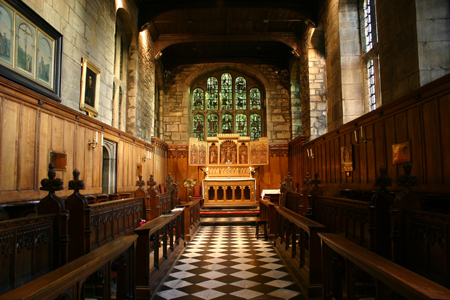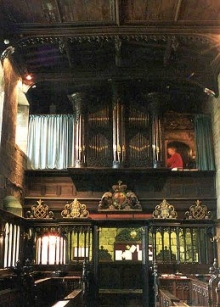Tunstal Chapel
 The
Tunstal Chapel is the larger of the castle's two chapels and was built
by Bishop Tunstal in the 1540's at the same time as the Tunstal Gallery.
Originally the chapel was shorter, the original line of the altar being
shown by the position of the piscina hidden behind the wall panelling
on the right-hand side. The chapel was extended by Bishop Cosin and Bishop
Crewe in the late seventeenth Century and the extension is obvious from
the pronounced change in stonework between the east and west ends. The
stonework of the east window is the original, having been moved when the
extension was built, and the stained glass dates from the late nineteenth
century.
The
Tunstal Chapel is the larger of the castle's two chapels and was built
by Bishop Tunstal in the 1540's at the same time as the Tunstal Gallery.
Originally the chapel was shorter, the original line of the altar being
shown by the position of the piscina hidden behind the wall panelling
on the right-hand side. The chapel was extended by Bishop Cosin and Bishop
Crewe in the late seventeenth Century and the extension is obvious from
the pronounced change in stonework between the east and west ends. The
stonework of the east window is the original, having been moved when the
extension was built, and the stained glass dates from the late nineteenth
century.Some of the seats towards the back of the chapel are sixteenth century 'misericords' (meaning 'mercy seats'), which were designed to be lifted up so that a person standing for long periods of time could rest on the ledge on the underside of the seat. The decorative organ pipes (which hide a modern organ) and the woodwork beneath are seventeenth century and come originally from Durham Cathedral, which is just a few hundred yards away. The altar and reredos (the screen behind the altar) date from the late nineteenth century, although the central carvings were originally part of seventeenth century German pulpit.

